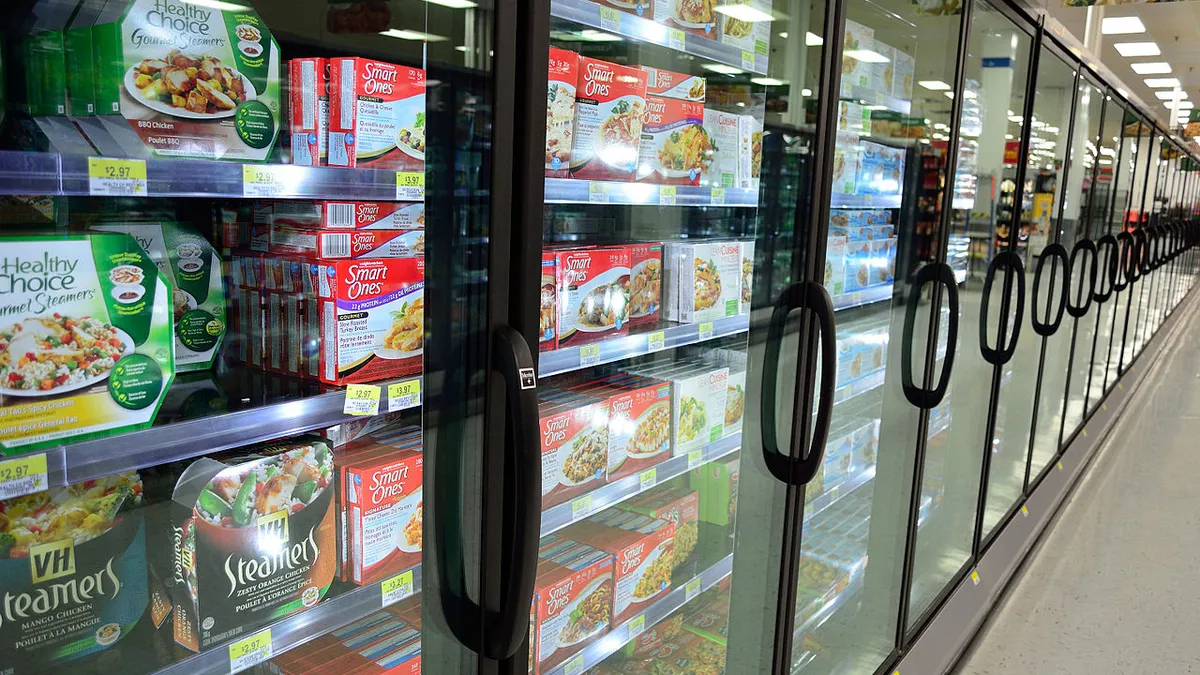Dive Brief:
-
Frozen foods are seeing an uptick in sales, with category volume growth up 1% for the 12 weeks ending March 10, according to a report from RBC Capital Markets covered by Market Watch. That's the first positive volume growth in five years, the report stated, with the largest increase of 3% coming from meals and appetizers.
-
For the past 10 years, analysts say frozen food has suffered from a stigma, as consumers look for what they perceive as healthier whole foods and avoid those they view as too processed or containing unwanted additives and preservatives.
-
Part of this renewed interest is due to convenience and relatively low prices, but also from the application of quick-freeze technology. This technique is better at keeping nutrients and flavor in the products, the report noted, while fresh foods often end up being thrown out if they aren't consumed quickly enough.
Dive Insight:
Research shows consumers are visiting the frozen foods area more often these days. And while all ages said they were purchasing more, 43% of millennials said they had bought more frozen items than the previous year. Convenience was a main driver, and shoppers said they used frozen foods as easy dinner options, for kids' breakfasts, as side dishes and for handy lunches.
Besides innovating by developing new items, adding protein to power bowls and otherwise staying on-trend, the industry has had to prove its products are just as healthy, fresh and convenient as fresh ones. It's helped the category that more people are cooking or assembling their own meals, the population is getting older, and more employees are working at home — all factors that add up to more purchases of frozen entrées and snacks, the RBC report says.
Manufacturers have focused on taste and revamped marketing approaches by pitching newer offerings as warm, comforting food that is also flavorful, interesting and better-for-you. This combination makes frozen meals appear to be anything but stodgy and predictable — something from which the old TV dinner of the past tended to suffer.
Nestle scored fans by reinventing and reinvigorating its Lean Cuisine brand with updated packaging and new options, such as Vermont White Cheddar Mac & Cheese "made with organic pasta" and "No GMO ingredients." Before these changes, the sales of the brand had dropped 20% over two years.
Conagra has recognized the opportunities in the frozen food space and recently signaled its intention to take further advantage. At a Feb. 20 presentation at the Consumer Analyst Group of New York, President and CEO Sean Connolly said the company is "clearly well-positioned" to capture more business in the category, which has admittedly lagged in recent years.
"It got sluggish not because people stopped appreciating the convenience of frozen, it got sluggish because big companies took their eye off the ball and didn't modernize their brands with changing consumer tastes," he said.
Conagra has introduced larger Banquet Mega meals, Healthy Choice Power Bowls, and a Frontera Barbacoa Taco Bowl to appeal to different tastes. The company also plans to bring out a line of meatless Healthy Choice items to capture more of that growing market.
It's taken time for the frozen category to get back into favor with consumers, but it is likely to grab more market share as long as manufacturers continue to innovate, keep prices down and appeal to the desire for healthy and flavorful products among different age groups and for every meal and snacking opportunity. Fresh foods will hold their own, but the convenience element of frozen foods still remains its biggest asset.








